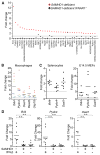Mouse SAMHD1 has antiretroviral activity and suppresses a spontaneous cell-intrinsic antiviral response
- PMID: 23972988
- PMCID: PMC4807655
- DOI: 10.1016/j.celrep.2013.07.037
Mouse SAMHD1 has antiretroviral activity and suppresses a spontaneous cell-intrinsic antiviral response
Abstract
Aicardi-Goutières syndrome (AGS), a hereditary autoimmune disease, clinically and biochemically overlaps with systemic lupus erythematosus (SLE) and, like SLE, is characterized by spontaneous type I interferon (IFN) production. The finding that defects of intracellular nucleases cause AGS led to the concept that intracellular accumulation of nucleic acids triggers inappropriate production of type I IFN and autoimmunity. AGS can also be caused by defects of SAMHD1, a 3' exonuclease and deoxynucleotide (dNTP) triphosphohydrolase. Human SAMHD1 is an HIV-1 restriction factor that hydrolyzes dNTPs and decreases their concentration below the levels required for retroviral reverse transcription. We show in gene-targeted mice that also mouse SAMHD1 reduces cellular dNTP concentrations and restricts retroviral replication in lymphocytes, macrophages, and dendritic cells. Importantly, the absence of SAMHD1 triggered IFN-β-dependent transcriptional upregulation of type I IFN-inducible genes in various cell types indicative of spontaneous IFN production. SAMHD1-deficient mice may be instrumental for elucidating the mechanisms that trigger pathogenic type I IFN responses in AGS and SLE.
Copyright © 2013 The Authors. Published by Elsevier Inc. All rights reserved.
Figures




References
-
- Banchereau J, Pascual V. Type I interferon in systemic lupus erythematosus and other autoimmune diseases. Immunity. 2006;25:383–392. - PubMed
Publication types
MeSH terms
Substances
Associated data
- Actions
- Actions
- Actions
Grants and funding
LinkOut - more resources
Full Text Sources
Other Literature Sources
Molecular Biology Databases
Miscellaneous

